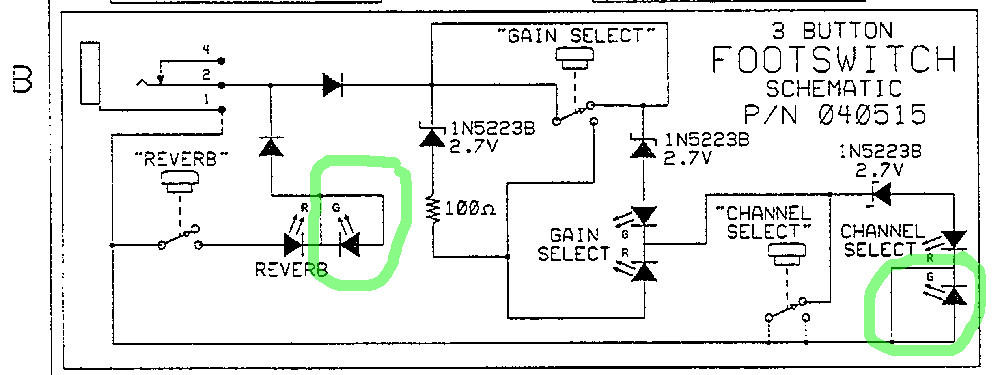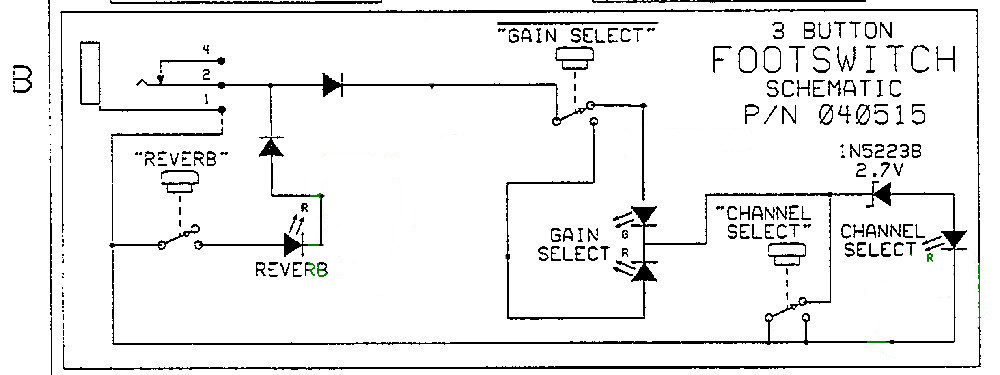edit to add: For reference - this has been solved. My successful circuit just used the original circuit included in this post. Worked like a charm. Hopefully the photo server I used doesn't go black in the future, but if it does you can find the footswitch schematic on the full amp schematic for Fender Roc Pro 1000 (same as Performer 1000).
You can use a simple single red LED (where circled in highlight) because "reverb" and "channel select" are dark when off anyway. Otherwise a three-lead 2-color LED will work for all three as the green leg is just shorted to ground.
Hi folks.
I am trying to get a buddy's Roc Pro 1000 amp head working, with some success so far. I found the schematic & parts list, ordered a bunch of stuff from Mouser and did a shotgun replacement of a couple dozen parts (or so). This was my path of least resistance because though I fiddle with electronics a bit, I don't know much really so I'm kinda lost tracing a signal or the like to do actual troubleshooting unless it's fairly basic, i.e. I could trace a signal, but I wouldn't know the diff between what the scope shows vs. what it's supposed to show.
Originally the clean channel worked but it wouldn't switch to the gain channel even though the LEDs indicated it was. Replaced electrolytics & high-watt resistors just because, FETs and the op-amp chips because I'm actually good at board re-work and have the tools for it, so felt confident. Anyways, after that, the amp is working correctly now, so whatever was the problem seems to have been exorcized.
Here's my question: buddy doesn't have the foot pedal but I saw that the circuit is shown on the schematic, and it's pretty simple. I figured I could just build one for cheap. However, I see a couple strange things going on for a couple of the indicator LEDs Looks to me that they are basically shorted between the two legs and there's nowhere for the current to flow through them. Is this an error on the schematic or am I just too dumb to know what's going on with them?
Here's a capture of the section I'm talking about:

Isn't the two LEDs I circled just shorting the two legs on the green side and won't light up? Maybe this is supposed to just be a two-color R/G led and it's just supposed to go dark for green? I dunno. I just figured I'd use separate LEDs since I've got them in a bin, but should be the same as a two-color LED. Anyways, maybe I'm just reading it wrong, but it sure appears that it's either got typos or some other magic Kung Fu is going on that I don't understand.
Anyway, I'd appreciate if somebody took a glance at this schematic and let me know if it looks right in general or totally wrong and won't even work. It would be cool if it worked because I could basically make it for free since I have all the parts in my stash already.
Thanks for any help - it is definitely appreciated.
You can use a simple single red LED (where circled in highlight) because "reverb" and "channel select" are dark when off anyway. Otherwise a three-lead 2-color LED will work for all three as the green leg is just shorted to ground.
Hi folks.
I am trying to get a buddy's Roc Pro 1000 amp head working, with some success so far. I found the schematic & parts list, ordered a bunch of stuff from Mouser and did a shotgun replacement of a couple dozen parts (or so). This was my path of least resistance because though I fiddle with electronics a bit, I don't know much really so I'm kinda lost tracing a signal or the like to do actual troubleshooting unless it's fairly basic, i.e. I could trace a signal, but I wouldn't know the diff between what the scope shows vs. what it's supposed to show.
Originally the clean channel worked but it wouldn't switch to the gain channel even though the LEDs indicated it was. Replaced electrolytics & high-watt resistors just because, FETs and the op-amp chips because I'm actually good at board re-work and have the tools for it, so felt confident. Anyways, after that, the amp is working correctly now, so whatever was the problem seems to have been exorcized.
Here's my question: buddy doesn't have the foot pedal but I saw that the circuit is shown on the schematic, and it's pretty simple. I figured I could just build one for cheap. However, I see a couple strange things going on for a couple of the indicator LEDs Looks to me that they are basically shorted between the two legs and there's nowhere for the current to flow through them. Is this an error on the schematic or am I just too dumb to know what's going on with them?
Here's a capture of the section I'm talking about:

Isn't the two LEDs I circled just shorting the two legs on the green side and won't light up? Maybe this is supposed to just be a two-color R/G led and it's just supposed to go dark for green? I dunno. I just figured I'd use separate LEDs since I've got them in a bin, but should be the same as a two-color LED. Anyways, maybe I'm just reading it wrong, but it sure appears that it's either got typos or some other magic Kung Fu is going on that I don't understand.
Anyway, I'd appreciate if somebody took a glance at this schematic and let me know if it looks right in general or totally wrong and won't even work. It would be cool if it worked because I could basically make it for free since I have all the parts in my stash already.
Thanks for any help - it is definitely appreciated.


Comment